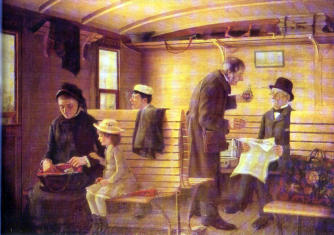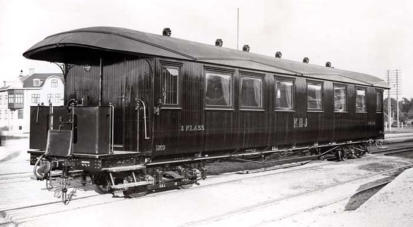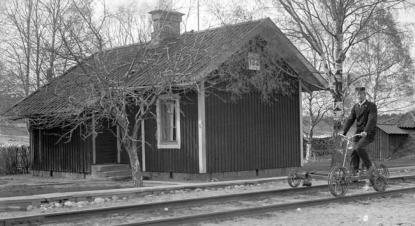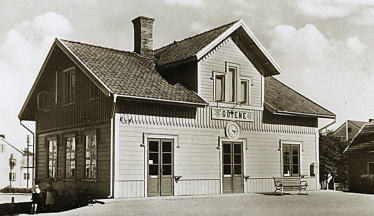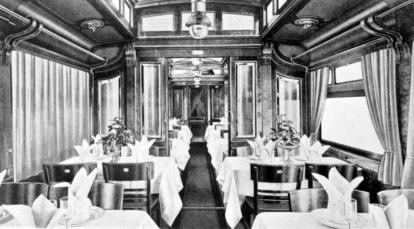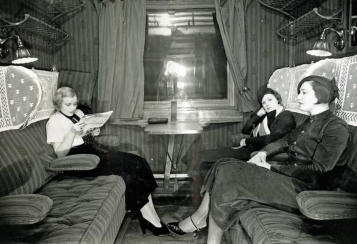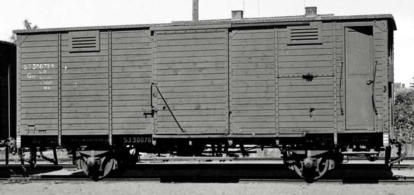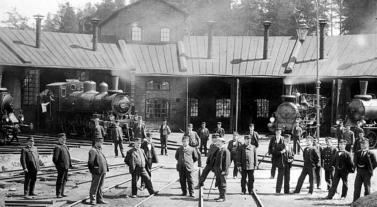
Copyright © Hans Högman 2021-03-18
History of Railways in Sweden (2)
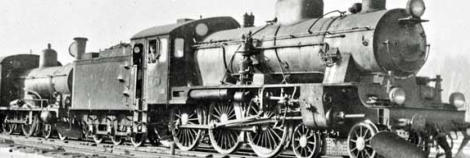
Swedish State Railways, SJ
Train Speed
Before 1907, the maximum speed allowed on the
Swedish railways was 85 km/h (53 mph) during
summers and 75 km/h in (47 mph) winters, however,
from 1907 the maximum speed was 90 km/h (56
mph) all year round. In 1946 some stretches were
allowed a maximum speed of 120 km/h (75 mph) and
in 1948 130 km/h (81 mph).
From 1985, train sets pulled by Rc3 and Rc6 class
locomotives on the Western Main Line are allowed a
maximum speed of 160 km/h (99 mph). ATC was
installed on the entire Western Main Line in 1989 and
thereby adapted to fast express trains. In 1990, the SJ
concept for fast express trains, Train X 2000, was
introduced with a speed of 200 km/h (124 mph).
Railway Carriage Comfort Classes
Initially, there were three classes of railway carriage
comfort.
The first class corresponded to the highest degree of
comfort while the third class was the simplest,
usually with wooden benches. The second class was
an intermediate form of the two others.
The
image shows the interior of a Swedish third-class
railway carriage around 1900. Painting by Oscar
Stenvall (1856-1916). Image: Wikipedia.
In the 1900s, there was an equalization of the comfort
in the three different classes of comfort and the
number of travelers in first calls was less than in the
other classes. In the 1900s, the difference between
the different classes was foremost the space for each
passenger. A first class railway compartment had 4
seats, a second class compartment six, and a third
class eight. Besides, not every line had first class
carriages.
In 1956, the third class was abolished.
Types of Trains
During the first decades of railways, locomotives were
the major cost for the railway companies. The train
speed was initially very low and to improve the profit
many carriages were coupled together in the same
train set. That increased the profit at a low cost. In the
beginning, there were no specific passenger trains or
goods trains, passenger carriages, and goods wagons
were mixed in the same train set. However, when the
railways expanded the number of passengers
increased as did the goods. The passengers wanted a
fast ride while the goods demanded larger heavier
loads. These two demands were incompatible.
Therefore, the trains were separated into fast trains
carrying passengers, passenger trains, and slower
trains carrying heavy cargo, goods trains.
The goods wagons are hauled by one or more
locomotives. Depending on the country, goods trains
are also called freight trains or cargo trains.
A passenger train includes passenger-carrying
vehicles and can often be very long and fast.
Passenger carriages are also called coaches, or cars
depending on the country. Passenger trains travel
between stations or depots, where passengers may
board and disembark. In most cases, passenger trains
operate on a fixed schedule and have superior track
occupancy rights over freight trains. The oversight of a
passenger train is the responsibility of the conductor,
who is sometimes assisted by other crew members
such as service attendants or porters.
A passenger train might also carry express goods or
light cargo. These trains stopped at most train
stations. In Swedish these types of passenger trains
were nicknamed “mjölktåg” (milk trains). Fast trains
did only stop at major stations and were called
“snälltåg” (express trains). The faster express trains
were very popular and you had to buy a
supplementary ticket to have a ride with a “snälltåg”,
so-called “snälltågsbiljett”. These express trains were
introduced in Sweden in 1862 on the Western Main
Line between Stockholm and Gothenburg.
The railway Carriages
There are many different types of carriages
depending on use. A passenger car (passenger wagon
in the US, passenger carriage, or passenger coach in
the UK) is an item of railway rolling stock that is
designed to carry passengers. The term passenger car
can also be associated with a sleeping car, a baggage
car, a dining car, or a railway post office.
Freight cars (US) or goods wagons (UK) are items of
railway rolling stock designed to carry goods.
The early passenger carriages were shorter than
today’s carriages and until the end of the 1800s
constructed of wood. The interior was divided into
separate compartments with an outer door to each
compartment, so-called side-door compartments. This
wasn’t very practical since passengers couldn’t reach
other compartments from inside. Later, a passageway
was introduced in the carriages, placed on one side of
the interior of the carriage, with doors located at the
ends of the carriage.
The image shows an SJ second-class railway
compartment, 1930s. Image: Järnvägsmuseet, ID:
JvmKDAF04728.
Generally, the comfort was very simple in the early
passenger carriages. Lightning was obtained from
candles or oil lamps and there was no heating, which
was troublesome during cold Swedish winters. By the
time, the length and weight of the carriages
increased. In the 1920s, the length of Swedish
carriages varied between 18 and 22 meters (59 to 72
ft) on standard gauge tracks. In the 1800s most
carriages have 2 or 3 axles but in the 1900s most
carriages were delivered with bogies (two axles per
bogie). A bogie in the UK, or a railroad truck, or wheel
truck in the US, is a structure underneath a railway
vehicle to which axles (and, hence, wheels) are
attached through bearings. Bogies were producing a
more comfortable ride for passengers and made it
possible to construct longer carriages, up to 27,50
meters (90 ft).
The first passenger carriages used by SJ were built in
Germany in 1856, however, soon Swedish companies
began producing railway carriages.
The image shows a Swedish third-class passenger
railway carriage in 1917. The carriage was
manufactured in 1917 for Kalmar - Berga Järnväg, KBJ.
Image: Kalmar Läns Museum, ID:
KLMF.Kalmar00002Mc.
The sleeping carriage or sleeper is a railway
passenger car that can accommodate all passengers
in beds of one kind or another, primarily to make
nighttime travel more comfortable. SJ introduced
sleeping carriages in 1886 and each sleeping
compartment usually has two or three beds. This type
of sleeping carriages are known as couchette carriages
with bench-configuration seating during the day and
double- or triple-level bunk-beds at night. Each
sleeping compartment is accessed from the side
corridor of the carriage.
A dining car (USA) or a restaurant carriage (UK),
also a diner, is a railway passenger carriage that
serves meals in the manner of a full-service, sit-down
restaurant. It is distinct from other railway food
service cars that do not duplicate the full-service
restaurant experience, such as buffet cars, carriages in
which one purchases food from a walk-up counter to
be consumed either within the car or elsewhere in the
train. Dining cars are a normal part of long-distance
trains.
The first restaurant carriage in Sweden was
introduced in 1894 on the Uppsala-Gävle Railway.
Elegance is one of the main words used to describe
the concept of dining on a train at this time.
The image shows the interior of a Swedish restaurant
carriage at the beginning of the 1900s. Image:
Järnvägsmuseet, ID: JvmKBDM02331.
Goods wagons, goods carriages, or freight wagons
(freight cars, USA), are unpowered railway vehicles
that are used for the transportation of cargo. There
are a large variety of wagon types in use to handle
different types of goods. At the beginning of the
railway era, the vast majority of goods wagons were
four-wheeled vehicles of simple construction. These
were almost exclusively small covered wagons, open
wagons with side-boards, and flat wagons with or
without stakes. The covered wagons usually had
sliding doors. These goods wagons are nicknamed
“godsfinka” in Swedish. Over time, an increasing
number of specialized wagons were developed for the
transport of goods such as iron ore, timber, oil, etc.
Initially, goods trains still ran at top speeds of only
about 30 km/h (20 mph). However, the introduction of
through brakes using air pipes from the 1920s
enabled higher speeds to be safely achieved.
The image shows an SJ goods wagon (“godsfinka”)
from the first decades of the 1900s. Image:
Järnvägsmuseet, ID: JvmKDAJ0230.
Carriages and wagons hauled by a locomotive are
coupled together forming a train. They are coupled
using standardized couplers.
In Sweden, usually, 13 carriages are coupled together
to make a train.
Others:
At the beginning of railways, smoking was allowed in
all passenger carriages. However, later special
smoking compartments (smokers) were introduced.
From trains, operating in the Scandinavian northern
climate, it was necessary to have heated passenger
carriages in winter. There were different solutions for
this; iron stoves in each carriage or steam from the
locomotive distributed to each carriage in pipes. From
1871, there were special steam wagons (Swe: ångfinka)
producing hot steam distributed to the carriages.
However, once the railway lines were electrified, the
heating was done electrically.
Initially, toilets were very primitive, merely a hole in
the floor which deposited the human waste onto the
railway tracks. There were signs in the toilets stating
“refrain from using the toilet while the train is at a
railway station”. Later special holding tanks were
introduced.
In the 1800s, long-distance trains made longer stops
so that the passengers could get off the train and dine
at the train station restaurant. Later special
restaurant carriages were coupled to the trains so
the passengers could dine aboard. In Sweden, these
railway diners were introduced in the 1890s. In the
1900s, also café or buffet carriages became common
as well as ambulatory service in the passenger
carriages.
In 1872 SJ introduced passenger carriages with
passages between the carriages.
Railway Stations
During the great expansion of the Swedish railways,
1850-1950, many railway stations were being built.
The station houses were usually magnificent
buildings, located centrally in towns. Many stations
were also placed in the countryside where towns grew
up around the station.
The Stationmasters competed to have a neat station
with tidy waiting rooms and nice flowerbeds
outdoors.
The Stationmaster is the person in charge of a
railway station. In the US the role is commonly termed
Station Agent. The Swedish term is “stationsinspektor”
or short “Stins”.
The first railway station built in Sweden was the
Fryksta station neal Kil in Värmland which was built
in 1852 by the Fryksta - Clara Elfs railway.
Railway stations were built along the railway lines and
each station comprised premises for the station
personnel and a waiting room for the passengers.
Major railway stations had also a restaurant. Larger
railway stations were also equipped with
accommodations for the personnel at the station.
Safety on the railway line passing the station was
watched over by the station personnel.
At a major railway station, besides the station house,
there usually was a goods warehouse, a railway yard
(switchyard (US)), signal box (tower (US)), and of
course platforms.
A railway junction (Swe: järnvägsknut) ) is a place at
which two or more rail routes converge or diverge.
This implies a physical connection between the tracks
of the different routes. A station that lies on or near a
railway junction is called a junction station. In Sweden,
if there are several railway stations in a place, the
primary station usually is called the Central Station, i.e.
part of the proper name for the railway station. The
Swedish term is “Centralstation”, abbreviated Central
or C, for example, Stockholm C.
The
image shows the Railway Station in Götene, VGJ, a
small town in Västergötland. Image: Västergötlands
museum, ID: 1M16-B145254:598.
A railway stop (Swe: hållplats) is an unattended stop
along a railway line where passengers can embark or
disembark a train. A railway stop has no station house
or switches but usually a shelter, a platform, and a
semaphore. The semaphore was used to signal to the
engine driver that you wanted to embark on the train
and he stopped the train at the platform. This was
foremost used for local or regional trains.
A loading area (Swe: lastplats) is a place along a
railway line where goods are loaded or unloaded. A
place where goods trains are coupled or decoupled is
called a railway yard or railroad yard (Swe:
rangerbangård) and is a complex series of railroad
tracks for storing, sorting, or loading and unloading,
railway cars and locomotives. These rail yards have
many tracks in parallel for keeping rolling stock or
unused locomotives stored off the mainline so that
they do not obstruct the flow of traffic. Railway
carriages are moved around by specially designed
yard switchers, a type of locomotive.
The motive power depot (railway depot) is the place
where locomotives are usually housed, repaired, and
maintained when not being used. They were originally
known as "running sheds", "engine sheds" or, for
short, just sheds. The Swedish term is “lokstall”.
Note, in American English, the term depot is used to
refer to passenger stations or goods (freight) facilities
and not to vehicle maintenance facilities.
The image shows the engine shed (“lokstall”) in
Katrineholm, Sweden, circa 1905. Image:
Järnvägsmuseet.
Trackman Cottages
A platelayer (UK) or trackman (USA) is a railway
employee whose job is to inspect and maintain the
permanent way of a railway installation. The Swedish
term is “banvakt” which means “track tender”.
Therefore I will use the US term trackman in this
article.
The Swedish railways employed a large number of
trackmen whose responsibility was to supervise and
maintain a designated part of the railway line. Not
only the tracks were supervised by trackmen but also
the embankment and the strip of land on both sides
of the embankment. The trackmen were obliged to
inspect their respective part of the railway line at
least once a day. This was performed either by foot
or on an inspection trolley (Swe: dressin). Each
trackman was assigned a specific stretch of the line
and each stretch covered between 2.5 km (1.6 mi) and
10 km (6 mi) or more.
Each trackman was working from an assigned railway
trackman cottage (Swe: banvaktsstuga) located on
their respective part of the railway line. These
cottages weren’t big but usually large enough to
accommodate the trackman and his family. The
trackman was also responsible for the maintenance
of his cottage. The trackman cottages usually had two
rooms and a kitchen, and the trackmen often kept a
cow, a pig, and a few chickens, and a garden where
they were growing vegetables and potatoes, etc.
The wages weren’t big either but they had a house to
live in and it was a secure and rather free occupation.
Most railway crossings were supervised by a
gatekeeper and if there was a crossing nearby a
trackman cottage, the wife of the trackman could earn
some extra money for the family as a gatekeeper
(Swe: grindvakt).
The image shows a trackman cottage in Wästra
Hästbo (X). The trackman is on his inspection trolley
(Swe: dressin). Photo: Josef Eriksson. Image:
Länsmuseet Gävleborg, ID: XLM.Torsåker1129.
The Swedish trackman cottages along the railway
lines were built from a standardized blueprint but the
design has been different in different decades. The
first cottages being constructed from the 1850s were
rather small, about 2,4 x 3 meters (8 x 10 ft.). The
entrance was on the gable facing the track. The next
design of the cottages was introduced in 1862. These
cottages were larger and had an extra room. Yet
another cottage design was introduced in 1872 and
this model was even larger and had 2 further rooms
and an entrance hall. The gable was facing the track
but the entrance was now on the long side. Attached
to the trackman cottage was a cattle shed with room
for one or two cows, a calf, and a pig or two. There
was also a shed for the tools needed by the trackman
to maintain the tracks.
The system of having trackmen supervising the
tracks was finally abolished around 1960.
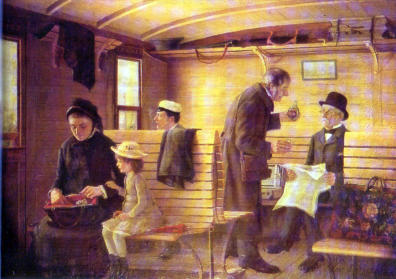
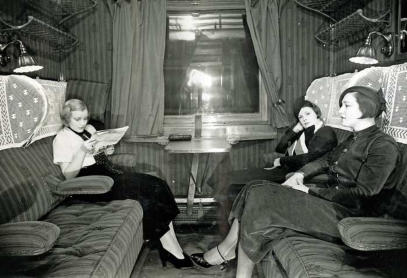
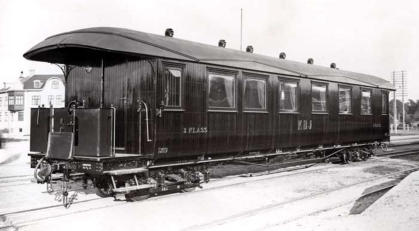
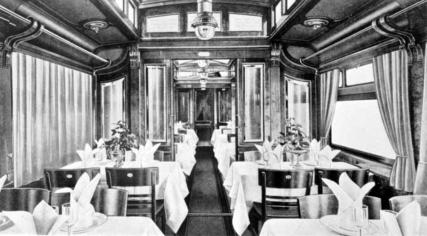
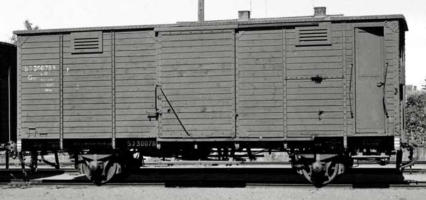
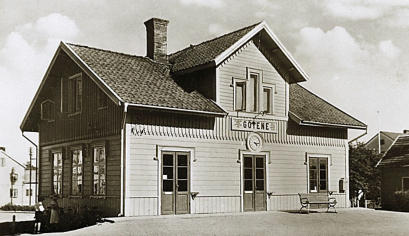
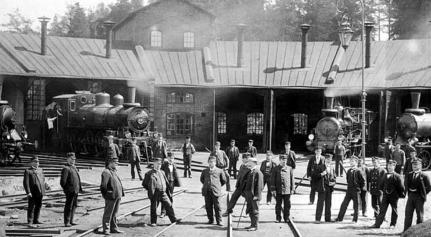
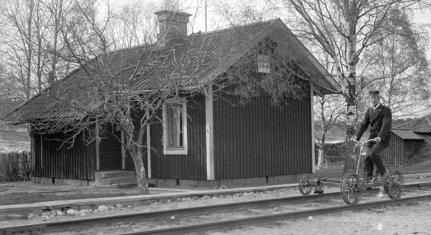

Related Links
•
Railway History, part-1
•
Railway Occupations and Uniforms
•
Swedish State Railways - Locomotives
•
Iron Ore Line
•
Railway History - Images
•
Maps of the Swedish Railway System
•
History of Swedish Log Driving
Source References
•
Staten, järnvägarna och den regionala
utvecklingen i Sverige 1840–1890, Agaton Sten,
2015, Umeå Universitet.
•
Den glade rallaren? Norrbottniska rallares syn på
sina arbets- och levnadsvillkor, Per-Jonas Pihl
2016, Luleå Tekniska Universitet.
•
Boken “En rallares levnadsminnen”, av Samuel
Magnusson Svanbäck; nedtecknade av Herbert
Malmback, 1931.
•
Boken: “Banbrytare. Äventyr och upplevelser under
ett 100-årigt järnvägsbyggande i Sverige”. Manne
Briandt. Kristianstad 1959.
•
Sveriges järnvägars historia, Populär Historia, 13
september 2006 av Niklas Ingmarsson,
publicerad i Populär Historia 7-8/2006 .
•
Rallarna i Sverige banade väg för industrialismen,
av Mats Utbult, publicerad i Populär historia
11/2009.
•
Wikipedia
•
Järnvägsmuseet (Railway Museum in Gävle,
Sweden)
Top of page
Different Timezones in Sweden
Before 1879, Sweden had different times or
timezones. It could differ as much as 45 minutes
between the easternmost and the westernmost parts
(Haparanda / Strömstad) of Sweden. The difference in
time between Stockholm and Gothenburg was 24
minutes.
This caused problems with timetables when the
railways expanded during the second half of the
1800s.
On 1 January 1879, a standard time zone was
introduced for the entire of Sweden. Swedish
standard time was set accordingly to the meridian
halfway between Stockholm on the east coast and
Göteborg on the west coast.
Electrification of the Swedish Railway System
In 1890, the Boxholms AB company began using an
electrified narrow-gauge industry line between the
different buildings at the steelworks. The line was
called Lönna Line (Lönnabanan) and was in use until
1966.
The first electrified railway line for passenger
transport was a suburban railway line in northern
Stockholm, Djursholmsbanan (Djursholm Line) later
called Roslagsbanan. Initially, it ran between
Djursholm north of Stockholm and Stockholm city
center. This commuter line was electrified in 1895 and
was one of the first electrified railway lines in Europe.
The line was later extended northward. A steam-
powered tram (streetcar) was used in Södermalm
District of Stockholm in 1887. In 1901, a major
introduction of electrified trams occurred in Sweden.
The first electrified railway line ran by the Swedish
State Railways (SJ) was initiated in 1915, the Iron Ore
Line (Swe: Malmbanan) in the northernmost part of
Sweden. The first electrified section of the line was
Kiruna–Riksgränsen. The entire Iron Ore Line, Luleå -
Riksgränsen, was electrified in 1923. The next railway
line to be electrified was the Western Main Line,
Stockholm - Gothenburg, which was entirely
electrified on 15 May 1926. The electrification of the
Southern Main Line was ready in 1932/1933. The
major period of electrification, when the remaining
main lines were electrified, took place in the 1920s
and 1930s.
In 1942, you were able to travel from Trelleborg on
the southernmost tip of Sweden to Riksgränsen in
North Sweden by electric trains, a distance of 2,022
km (1,256 mi). This was then the longest connected
electrified railway line in Europe.
Nationalization of Swedish Private Railways
Under the 1854 Parliament Act, the Swedish main
lines shall be constructed by the state, the
government, and the branch lines by private interests.
About two-thirds of the railway network, counted in
the number of kilometers, was thereby owned by
private companies. Gradually, many of the branch
lines were nationalized; the first private railway line
that was nationalized was the Hallsberg-Motala-
Mjölby Line after it had become insolvent in 1879.
In Norrland, the northern half of Sweden, some
shorter private lines were nationalized in connection
to the opening of the northern main lines, including
their branch lines down to the cost. In 1890, the
railway line between Luleå and Gällivare in North
Sweden was nationalized, mainly due to defense
political reasons. When the Inland Line was
constructed, the southern part of the line was
acquired by purchasing private railway lines, i.e. the
route between Kristinehamn and Sveg.
Under the Parliament Act of 1895, five private railway
lines in southern Sweden on the route Gothenburg
and Malmö on the west coast were nationalized.
Between 1927 and 1931, several private railway lines
became insolvent and pleaded to the government to
purchase these lines to avoid a close-down of the
lines. About 23 railway lines were taken over by the
government between 1920 and 1940. A major
takeover occurred in 1933 when the railways Uppsala-
Gävle (UGJ) and the then current Ostkustbanan
(OKB) on the route Gävle-Sundsvall-Härnösand, were
nationalized.
In 1933, there was a proposal in the parliament to
nationalize the entire railway network in Sweden. In
1938, after a study that resulted in a report, a
government bill was put forward in the parliament
regarding the nationalization of the private lines, and
the Act was passed on 17 May 1938 with a vast
majority of the votes. The Act was effective as of
January 1939. The nationalization was implemented
through voluntary agreements with the private
railway companies and the government purchased
these companies’ shares between 1940-1952.





























































































































































































































































































































































































